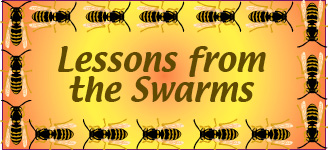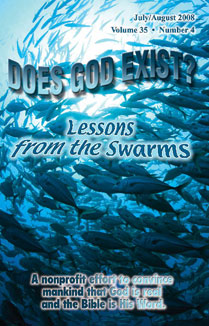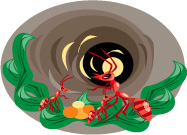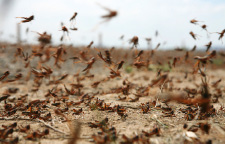


 The picture on the cover (shown at
the left) is one that most of us have seen in person. We have seen
swarms of starlings in the fall flying as a mass--dipping and diving as
they move across the countryside. We have seen pictures of swarms of
fish in the ocean including Bigeye Jack swimming in a large circle, or
herring swimming as a huge cloud. Most of us have seen documentaries of
caribou in Alaska or wildebeest in Africa crossing a river. There have
been pictures and movies made of Indonesian fireflies blinking in
unison resembling the beating of a human heart. We all know about ants
and bees and how they work as a unit with swarm behavior being the
guide. Individuals in these situations are dysfunctional, and
demonstrate very little intelligence. An ant by itself is inept, and
yet as a group, ants organize highways, build elaborate nests, stage
raids on enemies, and do a variety of things which demonstrate a very
high level of intelligence.
The picture on the cover (shown at
the left) is one that most of us have seen in person. We have seen
swarms of starlings in the fall flying as a mass--dipping and diving as
they move across the countryside. We have seen pictures of swarms of
fish in the ocean including Bigeye Jack swimming in a large circle, or
herring swimming as a huge cloud. Most of us have seen documentaries of
caribou in Alaska or wildebeest in Africa crossing a river. There have
been pictures and movies made of Indonesian fireflies blinking in
unison resembling the beating of a human heart. We all know about ants
and bees and how they work as a unit with swarm behavior being the
guide. Individuals in these situations are dysfunctional, and
demonstrate very little intelligence. An ant by itself is inept, and
yet as a group, ants organize highways, build elaborate nests, stage
raids on enemies, and do a variety of things which demonstrate a very
high level of intelligence.
There are some superficial gains that all of us know are made by
swarm behavior. Starlings and fish confuse predators by their swarms.
Ants and bees organize work by their swarm behavior--and in fact there
are businesses that have studied  these
behaviors and are using them to improve the
efficiency and profitability of the business. The question is how can a
swarm of ants have intelligence of a high degree when the individual
ants do not.
these
behaviors and are using them to improve the
efficiency and profitability of the business. The question is how can a
swarm of ants have intelligence of a high degree when the individual
ants do not.
Deborah Gordon, a biologist at Stanford University has done some
amazing study on the swarm behaviors of ants. This is reported in
National Geographic (July
2007, page 129). Ants are self
organizing--there are no generals, no bosses, and no external
management. A half million ants function, with each ant doing a
different job every day. Some ants forage, some maintain the nest, some
collect trash, and all of this job allocation is done at the beginning
of the day by a variety of techniques. Ants communicate by touching and
by smelling and this is one technique that is used. Ants that have been
outside the nest smell different than ants inside the nest. The ants
from outside the nest come in and touch the antennas of other ants,
with the rate of touching telling whether there is a need for more
patrollers outside of the nest. Foragers do not come back to the nest
until they find  food, so the rate of return of
foragers tells the other ants what is going on in the surrounding area.
When a rich source of food is found, the ants lay down a chemical trail
called pheromones for other ants to follow back to the food source.
food, so the rate of return of
foragers tells the other ants what is going on in the surrounding area.
When a rich source of food is found, the ants lay down a chemical trail
called pheromones for other ants to follow back to the food source.
Charles Harper in the Houston area has a business which supplies liquid gases. He has copied the ants in his business of supplying gases where there is a need. It takes hours with the biggest computers known, but it works. Southwest Airlines is engaged in a similar technique in handling their traffic at the Phoenix airport.
Another example of swarm intelligence is in bees where 50,000 worker
bees make group decisions, such as where to build a new hive. In the
spring a queen, drones, and half the workers will fly to a tree outside
the original hive. To find a place for a new hive there are certain
conditions that have to be met. The location has to be well off the
ground, have a small entrance hole facing south, and lots of room for
the hive. Thomas Seeley, a biologist at Cornell, brought a swarm of
bees to Appledore Island. He placed five nest boxes in the vicinity of
the swarm. Four of the boxes were too small to sustain the hive and
there was no other nest site or tree on the island. Scout bees visited
all of the boxes. They would come back to the swarm and do what is
called a "wiggle dance" near the swarm. Gradually the swarm migrated to
the one box that would meet their  needs,
something single bees would not do. There are
many other behaviors seen in bees that reflect swarm intelligence. One
is that when a cool wind blows into a hive, the bees on the outside
shiver and that behavior spreads through the other bees in the hive
warming the hive significantly and avoiding cold damage to the hive.
needs,
something single bees would not do. There are
many other behaviors seen in bees that reflect swarm intelligence. One
is that when a cool wind blows into a hive, the bees on the outside
shiver and that behavior spreads through the other bees in the hive
warming the hive significantly and avoiding cold damage to the hive.
In the case of birds, caribou, and other higher forms of life the animal pays close attention to the animal next to it. This avoids crowding and yet allows the animals to stay close to each other. The direction of the swarm's flight will be the average of the directions of the birds within the flock. A wolf attacking a herd of caribou will find that the animal he starts after will mesh into the herd and he will lose sight of it--inevitably shifting to another animal. That animal is fresher and in this process, eventually the wolf will give up in exhaustion while the herd will be still relatively fresh. Birds do the same thing, avoiding predation from hawks and eagles as the swarm keeps exposing different individuals to the predator's view, eventually frustrating the predator.
There are a multitude of lessons that come from our studies of swarm behavior. It would seem to this writer that the nature of swarm intelligence is such that to explain it on the basis of chance defies rational thinking. How do you build a behavior like this over a period of eons? Failure to protect is lethal in cases like this, and it would seem that swarm intelligence has to come from a greater intelligence that perpetuates the species by providing a multitude of techniques by which they can avoid overpredation.
 person
not be vulnerable to sexual predation and sinful
exploitation of all kinds. Sexual sin in humans normally does not
happen in group behavior, but happens when one is isolated with a
predator. A drunken orgy occurs when the group has isolated itself from
God and thus from the intelligence that designed the group. Animals
with swarm behavior can get into trouble as a group when it enters
environmental conditions that are designed by another outside
intelligence. In ancient times bison were killed by humans by running
the herd off a cliff. To do that, an outside intelligence had to
carefully plan to exploit the swarm behavior. God has told us how to
avoid the evil intelligence in the world, and if Christians follow what
God has given us the group--the Church--can be of massive help in
avoiding sin. "Forsake not the assembling of yourselves together, as
the manner of some is, but giving mutual encouragement and doing this
more and more as we see the final day drawing near" (Hebrews 10:25).
person
not be vulnerable to sexual predation and sinful
exploitation of all kinds. Sexual sin in humans normally does not
happen in group behavior, but happens when one is isolated with a
predator. A drunken orgy occurs when the group has isolated itself from
God and thus from the intelligence that designed the group. Animals
with swarm behavior can get into trouble as a group when it enters
environmental conditions that are designed by another outside
intelligence. In ancient times bison were killed by humans by running
the herd off a cliff. To do that, an outside intelligence had to
carefully plan to exploit the swarm behavior. God has told us how to
avoid the evil intelligence in the world, and if Christians follow what
God has given us the group--the Church--can be of massive help in
avoiding sin. "Forsake not the assembling of yourselves together, as
the manner of some is, but giving mutual encouragement and doing this
more and more as we see the final day drawing near" (Hebrews 10:25).Back to Contents Does God Exist?, JulAug08.